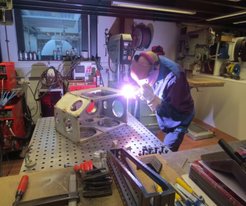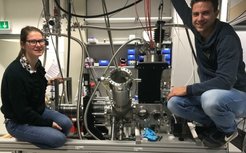Facilities
We typically work with home-built instruments offering measurement capability not available in other labs, following our overall strategy to pursue new means of measurements to obtain new knowledge. These techniques include:
1. State-to-state time-of-flight (Shirhatti et al. 2018)
2. Velocity resolved kinetics (Harding et al. 2017)
3. Infrared laser induced fluorescence with mid-IR single photon counting (Chen et al. 2017)
4. Inelastic surface scattering with a photolytic H-atom source and Rydberg atom tagging (Bünermann et al. 2018)
5. Bunch-compression photolysis (Kaufmann et al. 2014)
6. Field-free ion time-of-flight (Kaufmann et al. 2018)

The institute's infrastructure and master craftsman (Fig. 1) allow us to construct unique instruments. Eight custom instruments are presently being used for study of molecular interactions at surfaces and three more are nearing commissioning.
Beamer-1: Originally from UCSB this is a beam-surface scattering instrument for state-to-state inelastic scattering with high-power narrow-band infrared laser system for overtone pumping, employing a pulse amplified continuous wave ring dye laser with difference frequency generation and optical parametric amplification. State-to-state scattering is carried out using REMPI detection. Velocity resolved kinetics can also be carried out with this instrument.
Orientation machine: A beam-surface scattering instrument for quantum state prepared and oriented molecules with Fourier Transform limited home-built pulsed UV lasers for optical pumping by stimulated emission pumping or PUMP-DUMP-SWEEP. A special set-up for producing oriented molecules is available on this instrument. This employs a technique we developed called Optical state selection with adiabatic orientation.
Beamer-2: Two molecular beams are directed toward a surface and molecules scattering or desorbing from the surface are detected with ion imaging. Non-resonant multiphoton ionization with a high power Ti:Sapphire laser provides universal ionization of reaction products. Resonant enhanced multiphoton ionization is also available. This instrument is primarily used for velocity resolved kinetics studies, where site specific surface reaction rates have been obtained (Neugebohren et al. 2018).
RAT Machine: This is a Surface scattering Rydberg-atom tagging apparatus for study of translational inelasticity in H-atom surface collisions. Near mono-energetic H-atoms are produced by laser photolysis of hydrogen halides. H atom energies from 0.2 to 7 eV have been demonstrated. Scattered H atoms are detected by Rydberg atom tagging, providing high resolution time-of-flight data.
Chirality Machine: This is a compact machine with two molecular beams and a UHV surface scattering chamber with ion imaging detection. It is used to obtain photoelectron images that reveal chirality of molecules scattering or desorbing from surfaces.

Mid-infrared fluorescence spectrometer based on a Superconducting Nanowire Single Photon Detector (SNSPD): A UHV chamber contains a molecular sample adsorbed to a surface. Two pulsed molecular beams can be used for controlled surface dosing. SNSPDs are used in combination with a home built cryogenically cooled monochromator to perform dispersed mid-infrared fluorescence ( 3 m). Black body radiation can be directly observed or laser induced fluorescence can be performed, using pulsed IR laser light sources. FTIR absorption spectroscopy assists in characterizing conditions.
Sum-frequency generation (SFG) machine: This instrument allows ultrafast pump-probe experiments on adsorbates under UHV conditions. We use 100-fs light pulses from Ti:Sapphire oscillator/regenerative 1 kHz amplifiers. We also use Nd:YAG based narrow band ps lasers. All lasers are broadly tuneable for producing UV, VIS and IR pump and probe pulses.
UHV photo-desorption machine: An ultrahigh vacuum chamber holds a sample. IR laser pulses are used to induce multiphoton desorption. We are attempting to develop a highly sensitive means of detecting adsorbates. We envision multiphoton IR pumping leads to rapid desorption and gas phase detection by resonance enhanced multiphoton ionization.
In addition, three instruments are under construction.
Mobile Beamer: A project jointly funded by MPS, DFG and the Chinese Academy of Science (CAS) includes a mobile beam surface scattering instrument to be used at the Dalian Coherent Light Source (DCLS). With VUV photolysis using the DCLS, the instrument will produce electronically state-selected poly-electronic atoms with near mono-energetic translational energies, samples that will be used for inelastic and reactive scattering experiments.
HBEAM Machine: A successful ERC-Advance grant funds this project, where a new instrument is being set-up to produce pulses of H-atoms as short as 100 ps. These short pulses will be used to initiate reactions at surfaces and high time-resolution kinetics measurements will be performed. The instrument also provides the capability to investigate H-atom scattering from photo-excited surfaces.
Metal Oxide Kinetics machine: A previously used Stark-decelerator surface-scattering apparatus has been disassembled. The Stark decelerator was returned to Gerard Meijer and the surface scattering chamber is being adapted for velocity resolved kinetics studies of reactions on metal oxides. This instrument has XPS capability. Our emphasis here is to investigate the kinetics and dynamics of catalytically relevant reactions.
Additional infrastructure includes:
A local PC Cluster: implements VASP as well as FHI-AIMs for DFT calculations including ab initio molecular dynamics simulations. We also perform Independent-Electron Surface Hopping (IESH) calculations, and molecular dynamics with electronic friction. The cluster consists of 28 multi-core nodes providing over 800 threads. Intel and AMD processors run between 2.3 and 2.7 GHz. The cluster will be expanded to about 1600 threads in 2019 as part of the MPS-CAS project.
A nanoscience synthesis lab: A computer controlled CVD tube furnace and a Zeiss optical microscope are work horses here. We developed a new CVD approach to produce high quality graphene. A second Zeiss microscope has recently been obtained capable of fluorescence imaging. This is used for our work producing monolayers of transition metal dichalcogenides with CVD.
A Temperature programmed Desorption (TPD) instrument: A UHV chamber holds up to four samples that can be cooled below 30 K. TPD, Auger and LEED are also available. This chamber primarily serves undergraduates in the Chemistry program at the Uni-Göttingen. It is also used for small research projects when not needed for teaching laboratories.

